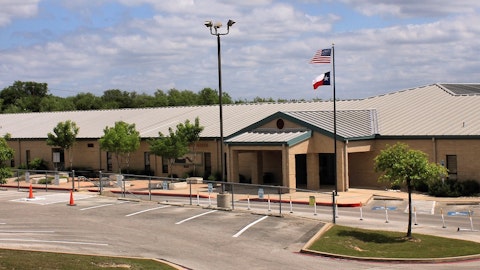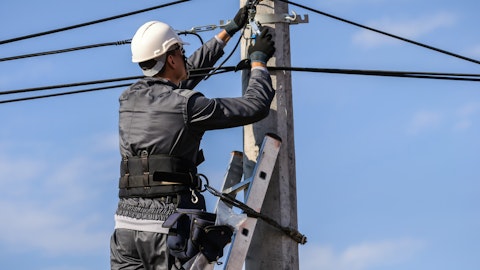AT&T Inc. (NYSE:T) Q1 2024 Earnings Call Transcript April 24, 2024
AT&T Inc. beats earnings expectations. Reported EPS is $0.55, expectations were $0.53. T isn’t one of the 30 most popular stocks among hedge funds at the end of the third quarter (see the details here).
Operator: [Call Starts Abruptly] 2024 Earnings Call. At this time, all participants are in a listen-only mode. [Operator Instructions] Following the presentation, the call will be opened for questions. [Operator Instructions] And as a reminder, this conference call is being recorded. I would like to turn the conference call over to your host, Brett Feldman, Senior Vice President, Finance and Investor Relations. Please go ahead.
Brett Feldman: Thank you, and good morning, everyone. Welcome to our first quarter call. I’m Brett Feldman, Head of Investor Relations for AT&T. Joining me on the call today are John Stankey, our CEO, and Pascal Desroches, our CFO. Before we begin, I need to call your attention to our Safe Harbor statement. It says that some of our comments today may be forward-looking, as such, they are subject to risks and uncertainties described in AT&T’s SEC filings, results may differ materially. Additional information as well as our earnings materials are available on the Investor Relations website. With that, I’ll turn the call over to John Stankey. John?
John Stankey: Thanks, Brett. I appreciate you all joining us this morning. We started the year with a solid first quarter, as we continue to make steady progress on our investment-led strategy, being the best connectivity provider through 5G and fiber. We’re growing the right way by adding valuable long-term wireless and broadband subscribers. Since Pascal will cover first quarter results in detail, I’d like to spend some time highlighting how our strategic priorities are enabling us to deliver positive results and build a long runway for sustainable growth. When you look under the hood, it’s clear that our largest and most powerful EBITDA growth engine mobility is running well. Our strength and value proposition help us deliver 349,000 postpaid phone net adds in the first quarter.
We now have about 71.6 million high value postpaid phone subscribers, which is up 1.5 million from a year ago, and these aren’t empty calorie additions. Our results reflect the quality of our customer growth with higher ARPU, higher adjusted operating income, improved margins and lower postpaid churn. We’re also growing efficiently, thanks to our consistent and simple go-to market strategy. Our postpaid phone churn of 0.72% was our lowest first quarter churn ever on record. And once again, we expect to report the lowest postpaid phone churn among the major service providers this quarter. This highlights the value customers place on the wireless service we provide and the continued strength of our best deals for everyone’s strategy. Now let’s move to fiber, which is our fastest growing engine.
The story here is familiar and one we like. Where we have fiber, we win, and we’re bringing fiber to more Americans than anyone else. Since the first quarter of last year, we passed about 2.4 million locations with fiber and now passed more than 27 million consumer and business locations. Over the last year, we grew our AT&T fiber consumer subscriber base by about 1.1 million to nearly 8.6 million customers. This includes 252,000 AT&T fiber net additions in the first quarter. As a result of our established fiber success in early AT&T Internet Air subscriber growth, we’ve grown our consumer broadband subscriber base for three consecutive quarters, and we expect this trend to continue. We’re even more excited about the converging power of 5G and fiber together, where we have AT&T Fiber, our strong national 5G wireless brand provides us the opportunity to be customers single converged provider seamlessly connecting them both in the home and on the go.
We’re able to deliver convergence at a level that none of our peers can match, as we’re the only provider that benefits from owners’ economics and scale with both 5G and fiber. This all matters because convergence presents clear benefits. When a customer has both our wireless and fiber products, we see a meaningful improvement in churn and net promoter scores. This ultimately translates to much higher lifetime values for converged customers. We are also making great progress on ensuring more Americans have access to high-speed Internet. Just this month, we expanded our commitment to $5 billion over this decade to help bridge the digital divide in our country. We’ve already contributed to connecting approximately 5 million Americans, and our goal is to help connect 25 million people in total by 2030.
We believe that connecting changes everything and that we must collectively address the communications capabilities of our country’s needs for the next century not the last one. To make this happen, we need sound policy, that’s done, right, and our teams are working hard to make that happen. The future of connectivity is critical to advancing our society. That’s why we’re focused on growing and evolving our networks. As a result of these efforts the areas, where we’re investing most heavily through 5G and fiber are performing very well. For a perspective, in 2023, mobility and consumer wireline together represented more than 80% of revenue and about 85% of EBITDA in our communications segment. This means, we’re growing the large majority of our business and driving improved operating leverage across it.
We expect this to continue. However, we still have legacy elements of our business that we’re in the midst of transitioning, particularly in business wireline. In the quarter, business wireline EBITDA was down 16.5%, as the industrywide secular decline of legacy voice continues. While the wholesale market is stabilized, the reality is that businesses are transitioning to mobile and cloud-based services at an accelerated rate, as post pandemic workplace restructuring takes hold. We see the benefits from this connectivity transition in business solutions, where wireless service revenues grew 4.6% in the first quarter, outpacing our overall mobility services revenue growth. While we continue to actively work our legacy transition strategies to end of life products, reduce our operating footprint and eliminate fixed costs, we’re advancing several cost savings and productivity initiatives to align with this reality, such as vendor and management workforce rationalization.
We also strongly believe that the future focused area of business solutions aligns well with our core connectivity competencies and we continue to build out a connectivity portfolio with real long-term growth opportunity. Take FirstNet. This prioritized service for first responders shows what we’re able to accomplish when we focus on growing our business in areas, where we have traditionally under indexed. Additionally, our continued 5G and fiber expansion will enable new growth when paired with broader distribution. We have relationships with nearly 2.5 million business customers today and an opportunity to win with more small to medium sized businesses. One way we intend to meet small and medium businesses connectivity needs is with our new fixed wireless service, AT&T Internet Air for business.
We believe this is a durable national play with business because it’s able to serve as a reliable 5G powered primary Internet Connection, where fiber is not available in remote locations when temporary access is needed or with small and medium businesses that don’t require always on video streaming. While it’s still early, we’ve been very pleased with the solid demand we’re seeing from businesses. Given our success, growing core connectivity, we’re focused on furthering the AT&T value proposition in ways that matter to our business customers and security is at the top of their list. That’s why we introduced AT&T Dynamic Defense, which provides built-in security controls on top of worldclass access. The takeaway is that we’re well positioned to capitalize on emerging connectivity opportunities with businesses thanks to the strong relationships we have with almost all the Fortune 1000 and our leading position in fiber and the fact we operate the largest wireless network in the US.
Our business wireline operations transformation will not be a linear process and we’re going through the heaviest lift right now. However, our strong momentum across our growth areas of mobility and broadband is allowing us to outpace legacy declines and drive positive consolidated results and we remain on track to deliver on all the consolidated financial guidance we shared in January. Now let’s spend a moment on our second priority of being effective and efficient in everything we do. Last year, we set a new target for an incremental $2 billion plus in run rate cost savings by mid-2026. This came on top of the $6 billion plus run rate cost savings target we achieved last year. The continued adoption of AI is not only helping us make progress on this goal, but also benefiting our employee and customer experiences.
This focus on efficiency is translating into improved operating leverage despite continued elevated inflation. You can see this in our cash operating expenses, which were down year-over-year in the first quarter contributing to adjusted EBITDA margin expansion of 170 basis points. This brings me to our final priority, which is our deliberate and balanced approach to capital allocation. As we indicated would happen, our capital investment levels have come down year-over-year, as we move past the peak of our 5G rollout. Still, we remain a top investor in America’s connectivity and continued to expand fiber at a steady pace. Even with this continued investment, we delivered first quarter free cash flow of $3.1 billion compared to $1 billion a year ago.
This aligns with the expectations we shared for more ratable quarterly free cash flow, which we’ve accomplished by efficiently growing EBITDA, improving cash conversion and reducing our short-term financing balances. Our strong free cash flow has also enabled us to pay down debt. We finished the first quarter with net debt to adjusted EBITDA of 2.9 times and continue to expect to reach our target in the 2.5 times range in the first half of 2025. So it’s clear we’re operating well against our business priorities, and as a result, we’re growing share with 5G and fiber. In mobility, we’ve been increasing our share of wireless service revenue growth even without the benefit of fixed wireless, which is reported in consumer wireline. We also expect that this will be the 11th time in the last 13 quarters, where we deliver the industry’s lowest postpaid phone churn.

In consumer wireline, we’re outpacing cable, as we add broadband customers. This is driven by AT&T fiber, which is consistently captured over one-third of broadband net adds across major providers for the past three years. So, in summary, across the services and technologies most important to the future, 5G and fiber were performing well and growing our share in a healthy industry environment. This gives me confidence in our strategy and tells me our team is making solid progress on our priorities. With that, I’ll turn it over to Pascal. Pascal?
Pascal Desroches: Thank you, John, and good morning, everyone, and let’s start by reviewing our first quarter financial summary on Slide 7. In the first quarter, revenues were down slightly as a decline in low margin mobility equipment revenues and business wireline revenues offset growth in high margin wireless service revenues and fiber revenues. Adjusted EBITDA was up 4.3% for the quarter, as growth in mobility, consumer wireline in Mexico were partially offset by continued decline in business wireline. For the full year, we still expect adjusted EBITDA growth in the 3% range. Adjusted EPS was $0.55 compared to $0.60 in the year ago quarter. In the quarter, there were about $0.11 of aggregated EPS headwinds from four items we discussed last quarter.
These include higher depreciation, higher non-cash postretirement benefit costs, lower capitalized interest, and lower equity income from DIRECTV. For the full year, our expectations remain for adjusted EPS of $2.15 to $2.25. First quarter free cash flow of $3.1 billion was up more than $2 billion compared to last year. The important takeaway is that improved conversion of EBITDA to free cash flow has allowed us to pay down short-term supplier obligations. The paydown of this facility should allow us to continue to drive more ratable quarterly free cash flow. Cash from operating activities came in at $7.5 billion versus $6.7 billion last year. As a reminder, the first quarter is typically the high watermark for device payments and we expect payments to get progressively lower throughout the year.
Capital investment for the quarter was $4.6 billion, down about $1.8 billion compared to the prior year. Capital expenditures were $3.8 billion, compared to $4.3 billion in the prior year. Now let’s look at our mobility operating results on Slide 8. The wireless industry remains healthy and our mobility business continues to deliver strong results, driven by our consistent go-to market strategy and solid execution. For the quarter, we reported 349,000 postpaid phone net adds. We grew service revenue by 3.3%, which included the impact of customer credits. This was offset by lower equipment revenues with postpaid upgrade rate of 3%, which was down from 3.7% last year. We continue to expect wireless service revenue growth in the 3% range for the full year.
Mobility EBITDA grew 7% or about $600 million year-over-year, which exceeded service revenue growth on a dollar basis. This demonstrates we’re significantly improving operating leverage and highlights the efficiency of our consistent go-to market strategy, which has enabled us to take costs out of the business. We now expect our mobility EBITDA to grow in the higher end of the mid-single-digit range this year, driven by better-than-expected performance with business wireless customers and continued disciplined cost management. Our postpaid phone ARPU was $55.57. This was up nearly 1% year-over-year, largely driven by higher ARPU and legacy plans. For the year, we continue to expect modest postpaid phone ARPU growth. Now let’s move to consumer wireline results on Slide 9.
Our growth in consumer wireline was led once again by our fiber subscriber growth, which has consistently yielded strong returns. In the quarter, we had 252,000 AT&T fiber net adds, which is in line with the outlook we provided. This is the 17th consecutive quarter with AT&T fiber net adds above 200,000. We now have fiber penetration of 40% with several markets well above that level. Broadband revenues grew 7.7% including strong fiber revenue growth of 19.5%. For the full year, we continue to expect broadband revenue growth of 7% plus. Fiber ARPU of $68.61 was up more than 4% year-over-year with intake ARPU remaining above $70. Consumer wireline EBITDA grew 14.6% due to growth in broadband revenues and ongoing cost transformation. We now expect consumer wireline EBITDA to grow in the mid to high-single-digit range this year, driven by continued strong fiber revenue growth and disciplined cost management, partially offset by continued legacy copper declines.
As our customer base continues to migrate to fiber from legacy services, our broadband support costs are decreasing, thanks to fiber’s more efficient operating model, greater reliability and higher quality service. And while fiber remains our focus and lead product, we continue to be encouraged by the early performance of AT&T Internet Air, our targeted fixed wireless service, which is available in parts of 95 locations. We now have more than 200,000 AT&T Internet Air consumer subscribers, having added 110,000 in the quarter. Ultimately, we couldn’t be more excited about the future of consumer wireline with AT&T fiber well positioned to lead our growth and AT&T Internet Air, helping us provide quality broadband service to customers, where we don’t offer fiber.
Now, let’s cover business wireline on Slide 10. Business wireline EBITDA was down 16.5% due to faster than anticipated rate of decline for our legacy voice services. At the start of the year, we shared that we expected business wireline EBITDA trends to improve on a full year basis. However, due to faster than expected decline of legacy voice services, we now expect full year business wireline EBITDA declines in the mid-teens range versus our prior outlook of a decline of 10% plus or minus. As John mentioned, we’re advancing several cost saving and productivity initiatives. This should benefit results in the second half of the year when we also have more favorable year-over-year comparison. As we transition this business, we believe our 5G and fiber expansion presents plenty of growth opportunities.
We’re already seeing this in some of the parts of our broader business solution results today. A great example is FirstNet, where wireless connections grew about 320,000 sequentially. We’re also pleased with early demand for AT&T Internet Air for business, which we expect to benefit results in the second half of the year. Now let’s move to Slide 11 for an update on our capital allocation strategy. Our approach to capital allocation remains deliberate. We’re successfully balancing long-term network investment to fuel sustainable subscriber and service revenue growth, paying down debt and returning value to shareholders. We remain on track for full year capital investments in the $21 billion to $22 billion range versus approximately $24 billion in 2023.
While our overall capital investment will be lower in 2024 compared to recent years, we continue to invest in key growth areas, given the compelling returns on these investments. In mobility, we are focused on modernizing our network through our Open RAN initiative and with fiber, we remain on track to pass 30 million plus consumer and business locations by the end of 2025. As we’ve stated before the better-than-expected returns, we’re seeing on our fiber investment potentially expands the opportunity to go beyond our initial target by roughly 10 million to 15 million additional locations. This also assumes similar build parameters and a regulatory environment that remains attractive to building infrastructure. It’s important to note that as we continue to build out our network this year, we expect to have lower vendor financing payments, while increasing the total investment we make directly into our networks, as we continue to invest in fiber expansion and wireless network transformation.
In other words, we expect our total capital investment and capital intensity to decline this year even as we boost investments in our network. We also remain laser focused on deleveraging. Over the last four quarters, we reduced net debt by about $6 billion. At the end of March, net debt to adjusted EBITDA was 2.9 times and we’re making steady progress on achieving our target in the 2.5 times range in the first half of 2025. As I mentioned last quarter, we expect to address near-term maturities with cash on hand, and this quarter, we repaid $4.7 billion of long-term debt maturities. Looking forward, our debt maturities are very manageable and we are in a great position with more than 95% of our long-term debt fixed with an average rate of 4.2%.
In addition to paying down debt, we reduced vendor and direct supplier financing obligations by about $2.3 billion during the quarter. This was partially offset by $400 million in additional proceeds on our securitization facility. These efforts highlight the quality of the free cash flow we’re delivering. DIRECTV distributions in the quarter were $500 million compared to $1.3 billion in the first quarter of 2023. For the year, and thereafter, we continue to expect DIRECTV cash distributions to decline at a similar rate to 2023 or by about 20% annually. With $3.1 billion in first quarter free cash flow, we’ve dramatically improved our free cash flow ratability just as we committed, we would last year. Looking forward, we still anticipate generating approximately 40% of our total 2024 free cash flow in the first half of the year and continue to expect full year free cash flow of $17 billion to $18 billion range.
To close, I’m really pleased with our team’s overall performance in the quarter. Despite managing through legacy declines, our strength in mobility and consumer wireline has us on pace to deliver on our full year consolidated financial guidance. Brett, that’s our presentation. We’re now ready for the Q&A.
Brett Feldman: Thank you, Pascal. Operator, we’re ready to take the first question.
See also 15 Best Places in Nebraska for A Couple to Live On Only Social Security and 20 Countries With The Highest Railway Passenger Traffic in The World.
Q&A Session
Follow At&T Inc. (NYSE:T)
Follow At&T Inc. (NYSE:T)
Operator: [Operator Instructions] Our first question will come from the line of Simon Flannery of Morgan Stanley. Please go ahead.
Simon Flannery: Great. Thank you very much. Good morning. Good to hear the reiteration of the 2.5 leverage target for early next year. It would be great if you could just go through how you’re thinking about the various capital allocation alternatives, buybacks, dividend growth, deleveraging, the 10 million to 15 million fiber adds BEAD investments. Any other considerations? And how we should think about the profile, presumably this time, next year, we will be having a more fulsome conversation. But anything more you could add around that would be great. And then just housekeeping on the outage. Maybe you could just size the credit for us? And was there any impact on net adds in the quarter? Thanks.
John Stankey: Good morning, Simon.
Simon Flannery: Good morning.
John Stankey: So I don’t know that I’m going to give you a whole lot more than what I previously said. I mean it’s really good to have choices, and we clearly have choices coming up, and we’ve worked really hard to put ourselves in this position to do that. And I told you there would be a very deliberate process that the Board would go through to understand what they want to do, as those choices start to materialize, and we’re in the middle of doing that. We are working through a pretty systemic process. And at the top of that, as you can well imagine, as we’re very cognizant of a desire to ensure that we’re treating our shareholders well and returning capital, where we can and doing it in a smart way. And so, as I’ve said before, we’ll evaluate at that time where things like interest rates stand, we’ll evaluate where we are on the dividend yield relative to the equity value, and where we have opportunities for reinvestment in the business and kind of understand what we think the right combination of those are.
And we have a pretty deliberate approach to making that happen. I would give you some characterization right now, as we’ve worked really hard over the last couple of years to ensure we protect the dividend. And I think you’ve seen that we’ve done that, and we’ve put ourselves in a really strong financial position. That’s paramount and important to us, as we move into this. You heard Pascal’s comments that we feel pretty good about where the balance sheet sits today relative to what we’re paying for the capital on the balance sheet and our abilities to manage that moving forward. I don’t feel like we’ve got some immediate need to move differently than the trajectory we’ve been on. So if I was waiting, we’ll be waiting against those other options that we think about and how we want to go and get the mix right.
So I think you’ll see more, as we get to the end of the year. As I said, the Board is working really hard on this issue and I don’t want to take away any degrees of freedom and latitude they have to debate it and figure out what they want to do, given what’s going on in the market at the time we arrive. On the outage, look, I’m upset that we had it. It’s unfortunate we had it. The entire team feels responsible for it. We know we can do better. We’ve put in place an awful lot of steps to ensure that we do better moving forward. I think I’m confident that we have done that and I feel like we can operate better than what we exhibited on that particular morning. Now having said that, I’m really proud of the way they responded to the circumstances when they occurred, and they managed through the situation as well as could be expected.
And in fact I think you see that in the metrics. You see that we had a really, really good churn quarter. Obviously, that wouldn’t happen if we didn’t do the right things with the customer base. I’m pleased relative to what I’ve seen reported so far in the industry of our customer growth. I’m sure there were a couple of days of maybe some suppressed activity as a result of the outage. I think it’s probably something that’s measured in days. It wasn’t measured in weeks and months. But we feel pretty good about where we stand right now. Certainly, as you might guess, we have a variety of survey methodologies that we use and research with our customer base and prospective customers. Those indicators don’t show me anything that causes me to be concerned about what transpired or what occurred.
I think some of our recovery methods that we use with our customer base was — they were the right decisions. And you’ve seen most of that reflected in the first quarter financials. There’s a little bit that will drag into the second quarter based on how bill rounds go, but you should expect that you’ve seen the bulk of that move through our numbers. And I’m satisfied that where we ended up on service revenue growth and margins that, that was a strong quarter in aggregate, inclusive of what we had to do in terms of the credits.
Simon Flannery: Excellent. Anything on BEAD? Yeah.
Brett Feldman: Go ahead. Go ahead, Simon.
John Stankey: Nothing that I think you know as I said last quarter, Simon, I think BEAD is a 2025 issue. It’s not a 2024 issue. It doesn’t feel like it’s moving in any particular way. All that fast at the state level. And as I’ve also indicated, it’s pretty clear to me that there’s places, where we’re going to be more energized about playing and places, where we’re going to be less energized about playing based on how various states are approaching this. And I don’t think there’s anything right now, I can tell you point blank, we won’t be coming back in with any revisions to our guidance or anything like that, that is relevant to 2024. I think as we through this year, there may be some incremental things that we talk about in 2025 in terms of how we choose to reinvest capital and where we choose to go. But it’s not anything that I see right now that’s front and center.
Simon Flannery: Many thanks.
Brett Feldman: All right. We’ll take our next question now, operator.
Operator: Our next question will come from the line of John Hodulik of UBS. Please go ahead.





